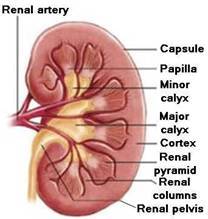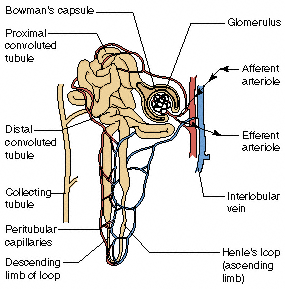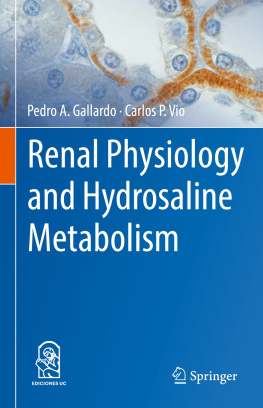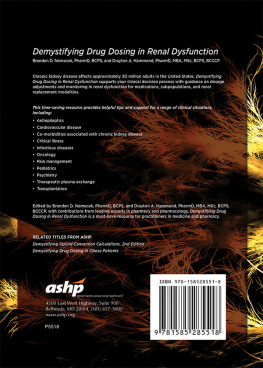C. G. Weber M.D. - Clinical Nephrology - 2020
Here you can read online C. G. Weber M.D. - Clinical Nephrology - 2020 full text of the book (entire story) in english for free. Download pdf and epub, get meaning, cover and reviews about this ebook. year: 2014, publisher: Primary Care Software, PC, genre: Home and family. Description of the work, (preface) as well as reviews are available. Best literature library LitArk.com created for fans of good reading and offers a wide selection of genres:
Romance novel
Science fiction
Adventure
Detective
Science
History
Home and family
Prose
Art
Politics
Computer
Non-fiction
Religion
Business
Children
Humor
Choose a favorite category and find really read worthwhile books. Enjoy immersion in the world of imagination, feel the emotions of the characters or learn something new for yourself, make an fascinating discovery.
- Book:Clinical Nephrology - 2020
- Author:
- Publisher:Primary Care Software, PC
- Genre:
- Year:2014
- Rating:5 / 5
- Favourites:Add to favourites
- Your mark:
- 100
- 1
- 2
- 3
- 4
- 5
Clinical Nephrology - 2020: summary, description and annotation
We offer to read an annotation, description, summary or preface (depends on what the author of the book "Clinical Nephrology - 2020" wrote himself). If you haven't found the necessary information about the book — write in the comments, we will try to find it.
Clinical Nephrology - 2020 — read online for free the complete book (whole text) full work
Below is the text of the book, divided by pages. System saving the place of the last page read, allows you to conveniently read the book "Clinical Nephrology - 2020" online for free, without having to search again every time where you left off. Put a bookmark, and you can go to the page where you finished reading at any time.
Font size:
Interval:
Bookmark:
Nephrology (Renal)
Contents:|
Primary editor Darol D. Joseff, MD,Nephrology & Hypertension.
Last updated on 03 NOV2019
http://clinicalmedconsult.com/
Weperform an ongoing review of most major journals, textbooks, and other online resources.Ongoing scientific information is added as the new and clinically relevantevidence is released. This is the only point of care medical reference createdfor portable electronic devices in a concise and compact format by physiciansand for physicians. The goal of this text is to bring all of the clinicallyrelevant information clinicians need during patient care directly to one'sfingertips. |
The Clinical MedicineConsult includes all 35 of ourmodules in the clinical medicine series in onehighly integrated text . All of these texts are in full 264k color. Currently the total illustrations / diagrams / color photos stands at >4,784. The iSilo version of this text comes with freequarterly updates for one year. Both the Kindle and iSilo versions can be read/ utilized on just about any portable device (android phone / tablet or iPhone,iPad etc), with the appropriate reader installed (get at your app store). |
Anatomy and Function
Link |


Thekidneys four main functions are:
Regulation ofelectrolyte and acid-base balance.
Disposition ofmetabolic byproducts and drugs.
Maintenance of volumestatus.
Organ-specificendocrine and metabolic effects.
1. Function:Maintain blood homeostasis: i.e., pressure, pH, ionic balance andconserve nutrients while eliminating wastes.
2. Nephron:Functional unit of kidney found in cortex/medulla. Kidneys regulate plasmacomposition via the nephron, by filtering plasma. The nephron carries outnearly all of the kidney's functions. Most of these functions concern thereabsorption and secretion of various solutes such as ions (e.g., sodium),carbohydrates (e.g., glucose), and amino acids (e.g., glutamate). Properties ofthe cells that line the nephron change dramatically along its length; consequently,each segment of the nephron has highly specialized functions. The averagenephron number is approximately 900,000 to 1 million per kidney (range 200,000to >2.5 million)(Pediatr Nephrol. 2011;26:1529-33)....No new nephrons areformed in human kidneys after approximately 36 weeks' gestation. Most healthyindividual lose 1 nephron per hour of life, those with diabetes andhypertension lose 6 per hour.
Compoundpapillae: When two renal pyramids fuse during their development, they form a compoundpapillae. They usually occur at the renal poles. Their physiologic significancelies in the fact that the configuration of the collecting ducts (of Bellini)allows for reflux of urine and potentially bacteria into the kidney. Renalparenchymal scarring secondary to infection is typically most severe, overlyingthese compound papillae.
Majorcalyx: There are usually two to three major calyces within a kidney. Each major calyxreceives two or more infundibula, each of which drain two or more minorcalyces.
Twomajor portions:
a. Renalcorpuscle: Blood enters Bowmans capsule via glomerulus wherea filtrate is formed.
Glomerulusand Bowmans capsule: filterplasma particles and fluid out of the blood vessels. Plasma is filtered fromthe glomerulus into Bowmans capsule at a rate of 125 mL/min. The constrictionof the afferent and the dilatation of the efferent arterioles cause a highhydrostatic pressure of 45 mmHg. Small particles are forced through intoBowmans capsule whilst larger proteins remain behind due to their size.
Juxtaglomerular(JG) apparatus: isa specialized association between the proximal aspect of the distal convolutedtubule and the afferent renal arteriole. Specialized macula densa cells withinthe renal tubule detect changes with intratubular sodium concentration. Theycommunicate with juxtaglomerular cells of the afferent arteriole that areresponsible for secreting renin into the afferent arteriole and renal lymph.The juxtaglomerular cells will respond to changes in wall tension and receiveinput from renal nerves that can stimulate renin secretion.
b. Renaltubules: Glomerular filtrate enters proximal convoluted tubule --> loopof Henle --> distal convoluted tubule --> collecting duct whereit is now urine.
3. Tubularsecretion and reabsorption:
a.Glomerular filtrate entering renal tubules consists mostly of plasmaminus proteins.
b. 180 L(47 gallons) of filtrate are produced per day.
c.Nearly all the plasma (and nutrients) must be reabsorbed by capillaries thatfollow the renal tubules.
 d. The loop ofHenle dips deep into the medulla of the kidney, which has an interstitialfluid laden with solutes to help the blood vessels reabsorb water. Thispart of the nephron concentrates the urine by reabsorbing most of the waterback down the osmolar gradient created by the countercurrent system. It doesthis by creating a large osmotic gradient in the medulla so that water is drawnout of the ultrafiltrate back into the capillary bed.
d. The loop ofHenle dips deep into the medulla of the kidney, which has an interstitialfluid laden with solutes to help the blood vessels reabsorb water. Thispart of the nephron concentrates the urine by reabsorbing most of the waterback down the osmolar gradient created by the countercurrent system. It doesthis by creating a large osmotic gradient in the medulla so that water is drawnout of the ultrafiltrate back into the capillary bed.
Renalmedulla osmolality is between 900 and 1400 mOsm/kg (much higher than the 285mOsm/kg in the plasma) and is created by active transportation of chloride,which is followed by sodium, into the medulla from the thick ascending limb.Urea contributes to the medullar osmolality as it leaves the distal collectingtubule down its gradient (once it becomes permeable to urea in the medulla)where it is concentrated. The descending limb of the loop is the only area inthe whole loop permeable to water and this is where water leaves theultrafiltrate (although most of it is reabsorbed in the proximal tubule). Thisis the countercurrent exchange system helped by vessels that follow the courseof the loop (vasa recta); sodium chloride is excreted in the ascending limb(which becomes hypo-osmotic at 100 mOsm/kg) and it causes water to bereabsorbed in the descending limb due to the surrounding high medullarosmolality. Magnesium is mostly reabsorbed here.
Proximaltubule (PCT): Mostreabsorption of electrolytes, water, glucose and amino acids occurs here.Seventy percent of the ultrafiltrate (particles and water minus any largeparticles) is returned back to plasma.
Mostof the filtered sodium is reabsorbed here, pulling water back into the vesselswith it.
Glucose and amino acids are completely reabsorbed here, using sodium as apassive co-transporter.
Potassium is also mostly reabsorbed here; against its gradient and presumablyin exchange with H+ ions.
H+ions are mostly excreted here; however, the pH of the solution only drops by0.4 (from 7.4 to 7) because the HCO3 is mainly (90%) reabsorbed here thusacting as a buffer.
Ureais concentrated here but due to the high gradient thus created, it isreabsorbed back into plasma.
Calcium and phosphate are passively reabsorbed here.
Distaland collecting tubules: fine-tuning of the final urine electrolyte compositionoccurs here, and hence the regulation of pH and electrolyte composition of theblood. Aldosterone acts on the collecting duct to reabsorb sodium and ADHcontributes to water reabsorption. These absorb only 5% of the filteredelectrolytes but control the final composition of the urine via the actions ofaldosterone and antidiuretic hormone (ADH). Ultrafiltrate coming into thedistal tubule has a low osmolality which drops further (from 100 to 5075mOsm/kg) because of their impermeability to water. Sodium is reabsorbed in thecollecting duct and potassium is secreted due to aldosterone. Collectingtubules permeability to water can be increased by
Next pageFont size:
Interval:
Bookmark:
Similar books «Clinical Nephrology - 2020»
Look at similar books to Clinical Nephrology - 2020. We have selected literature similar in name and meaning in the hope of providing readers with more options to find new, interesting, not yet read works.
Discussion, reviews of the book Clinical Nephrology - 2020 and just readers' own opinions. Leave your comments, write what you think about the work, its meaning or the main characters. Specify what exactly you liked and what you didn't like, and why you think so.















